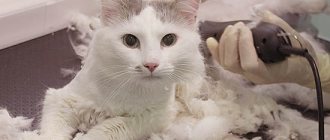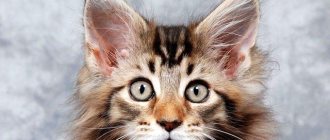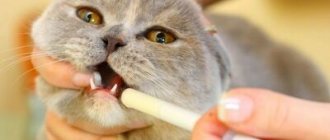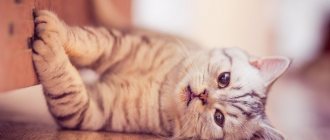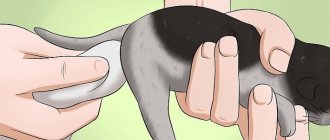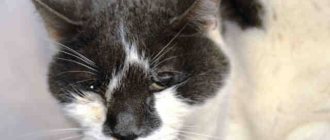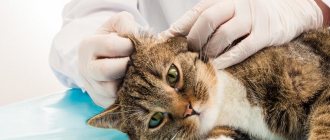Every owner of a mustachioed pet sooner or later has to face the need to find out its weight. You definitely need to weigh your cat if:
- he has noticeably gained weight or lost weight;
- you need to calculate the dose of the medicine relative to body weight;
— it is necessary to determine the daily amount of dry food.
Veterinarians use special scales similar to children's scales. But to weigh a cat at home, you have to use what you have. Many find absolutely incredible ways, starting with weighing a cat in a bag with a cantor and ending with attempts to lure it onto a floor scale with various delicacies.
Without scales at home
If you have decided to weigh your cat, but there are no scales at home, then you can show your imagination and weigh it using available materials. There are two most common methods, but human imagination is limitless, and you can come up with your own methods.
- First way. To do this, you will need a basket, bag or thick bag, as well as bottles of water of various sizes (from 2 liters to 0.5 liters). We tie a rope to the bag and throw it over any horizontally attached beam. To do this, you can use a sports horizontal bar (if you have one in your house). If the cat is not very large, then you can use a coat hanger in the hallway. Well, if the animal is of impressive size, then you can go outside and use a low-growing branch on a tree as a beam. We put the cat in a bag with a rope tied to it, and throw the other end over the beam. And then we tie eggplants with water to the other end of the rope. If the cat weighs, for example, 4 kilograms, then you need to take 2 bottles of 2 liters each. Well, accordingly, when the load and the bag with the cat meet at the same level, without an advantage in any direction, it means that the weight of the cat has been calculated.
- Second way. And also with the help of scrap materials. For this you need a board. You can take a board left over from the renovation, or a sheet of fiberboard will do. As a last resort, you can remove the shelf from the cabinet. Place any large book on the floor and cover it with a folded board. You will get an impromptu swing. Place a box on one side in which to place the cat. And on the second side you need to put bags, for example, with sugar, packaged in kilograms or 500 grams. This way, when the swing comes into balance, you can find out the weight of the cat.
Methods of weighing kittens and adult animals
The simplest and most common weighing methods include:
- Using household floor scales. First, the owner should weigh himself, and then with the cat in his arms. By subtracting your own weight from the result of joint weighing, you will find out the cat’s weight with an accuracy of 0.1 kg. If the cat scratches and shows signs of dissatisfaction, it is recommended to postpone the procedure or try another method.
- In a similar way, you can weigh a kitten or an adult cat using a cat house or any other container familiar to the cat. After all, shoe boxes or wicker baskets are often your pet’s favorite resting places.
- Using more accurate electronic kitchen scales, kittens and small breed cats are weighed.
- Using a manual steelyard. To use this method, you need to place the cat in a carrier bag, which not all pets like.
- Using special scales during a visit to the veterinary clinic. Typically this service is provided free of charge.
The optimal state for weighing is a well-fed, sleepy cat. Before weighing the cat, the animal should be calmed, and after the procedure, rewarded with its favorite treat.
On bathroom scales
To find out the cat's weight more reliably, you will need a scale. Floor-standing electronic ones are excellent for this purpose. Mechanical ones will also work, but the result obtained with them will not be as accurate. There are two ways you can weigh a cat on this type of scale.
- A masculine way, in which there is cold calculation and masculine logic. You just need to put the cat on the scale and find out how much it weighs. But the problem with this method is that the cat does not always sit quietly and can run away even before the readings of its weight are taken. Therefore, if you have decided to weigh your cat in this way, you should definitely put the scales in the corner of the room and pour some dry food on the corner of the scales. The cat will not be able to eat the food without stepping on the scale. And at this moment you can take readings. You can also put the scales in the place where the cat is used to sleeping and put a rug or towel on them so that the animal does not notice the catch. When the cat gets tired and goes to sleep, he will lie down in his usual place. The main thing is not to miss the moment and take readings while the animal is sleeping.
- Women's logic modernized the men's way. To find out the weight of a cat, just pick it up and weigh yourself with it. And then weigh yourself without the animal. The difference between these two indicators will be the cat's weight.
Measuring methods
Sometimes the condition of an animal can be judged by how it feels to the touch.
You can weigh your cat at home using electronic floor scales, a cantor and a bag. Ordinary scales can also help, but they are only suitable for large animals, or when measuring an animal with its owner, but you need to be prepared for a large error. Small cats are best measured on a kitchen scale, as they are designed to measure precise and light weights. If the cat is purebred, then the weight can be compared with the weight norm, which is prescribed in the passport. In some situations, you need not just weight, but general parameters, then you can simply touch the pet.
Measuring without scales
Measurement by condition - determining the appearance of the animal and its complexion. You should examine your pet's back by touch. A diet is required if the ribs and vertebrae are not noticeable under the fur or are barely noticeable. You need to increase the amount of food in situations where the cat’s sides are falling in and bones are protruding. The norm is considered to be a condition when the animal has a palpable skeleton when palpated, and the layer of fat is insignificant.
On a kitchen scale
Sometimes it is possible to achieve your plans with the help of a kitchen appliance.
They often have a bowl in which you can sit your pet if he is persistent. We are talking only about small kittens, since such a device is designed to accurately measure small weights. It is advisable to take measurements in the morning, when the animal has not yet eaten, but has already cleansed the intestines. If your pet is fidgety, it is very difficult to measure more accurately.
On bathroom scales
Floor and electric scales can only help when the owner is measuring with a cat. Initially, you should measure your weight and remember the result. Then you need to pick up the cat and measure the total weight of the animal. Next, you need to subtract the first number from the second number and get the pet’s body weight. This method of measurement gives a large error in the results, so it needs to be done several times.
On a kitchen scale
If the kitten is still small, you can weigh it on a kitchen scale. To do this, you need to put it in a cup and take the readings. But since small kittens are very active, it is better to weigh the kitten immediately after sleep so that he does not resist and does not try to turn weighing into a game. After all, if he jumps, the readings will be inaccurate.
Well, the easiest way to find out the weight of a cat is to weigh him at a veterinary clinic. There are precise scales there, and it won’t be difficult to find out the animal’s weight. Moreover, you basically need to know the weight of the animal precisely in order to correctly calculate the amount of medicine, for example, for vaccination. After all, obesity problems are not always associated with the fact that the cat overeats; sometimes this means problems with the intestines or digestive system, so if the cat shows signs of obesity, but its diet has not increased, it is worth showing the animal to a doctor. And if everything is fine with the cat’s health, then the veterinarian will select a balanced diet for him.
Which method to choose for weighing a cat is up to everyone to decide for themselves. After all, pets have different personalities, and there are not always scales in the house. But it is worth remembering that it is best to weigh animals in the morning, before the first meal.
What is important to know?
- It is better to measure your cat's weight in the morning before breakfast and after using the toilet.
- You need to weigh your pet regularly, on average once every 2-3 months. If he is sick, prone to rapid weight gain or loss, or is in the developmental stage, then it is better to do this more often.
- It is recommended to record the results and compare them with the cat's health. This will help determine her normal weight and ensure that it remains stable.
- It is believed that a cat gains a healthy weight by the age of one year, so this indicator (provided that the animal did not have any diseases at that time) should be maintained throughout its life.
- Thick and long hair can increase the weight of the animal, and this must be taken into account when controlling weight.
How to weigh a cat
To determine the exact weight of a cat, it must be weighed on an empty stomach, after emptying its bladder and defecating.
Using a kitchen scale (preferably not a flat scale, but one with a bowl), you can determine the body weight of a small kitten. Seize the right moment when he just woke up, ate or had a good run, otherwise it will be difficult for you to keep him in one place. There is only one disadvantage of this weighing method: it is not applicable for adult cats.
You can determine the weight of a cat in this way: place it in a fabric bag with handles, a cloth bag or a bag and quickly weigh it on a steelyard. The key word here is “fast.” Not all cats will be loyal to the procedure of placing them in a bag or package. The animal may meow heart-rendingly, resist the procedure and, ultimately, jump out and run away. In addition, rapid shocks can introduce a certain amount of error into your measurements. This weighing method is not suitable for very heavy and hyperactive animals.
It is best to weigh your cat using a floor scale. First, determine your weight on them, and then step on the scales with your cat. To find out its weight, you just need to determine the difference between these indicators. It is advisable to use electronic scales, as they have the least error.
If you have to visit a veterinary hospital, ask the doctor to weigh your cat on special scales. Veterinary institutions often use measuring instruments similar to scales for weighing newborn babies.
Algorithm:
1. Weigh yourself and remember the result.
2. Take the cat in your arms and weigh yourself with it.
It is better to do this 2-3 times to check the stability of the readings.
3. Subtract the first from the second indicator and get the desired weight of the cat.
Of course, if you don’t have such precise instruments, you can weigh the cat with a cantor. Usually cats themselves are happy to climb into an empty bag or bag. All you have to do is lift the bag and hook the handles with the cantor hook.
How to control the amount of dry food your cat eats?
#advice-from-the-vet-point
Often, when I draw the attention of owners to the fact that their cat is obese, I receive the answer in response: “she doesn’t eat much!” At the same time, in most cases, owners find it difficult to answer exactly how much a cat eats, and how this corresponds to the norm recommended by the manufacturer. And in most cases, the owner does not know how to measure what a cat eats when dry food is constantly available.
Controlling the amount of dry food eaten by a cat, if all family members feed it “at the cat’s request,” is a serious, almost impossible task for many cat owners.
Why control the food your cat eats?
So, if your cat has gained excess weight over the winter, or during an examination your veterinarian noted that your cat is obese, then it’s time to start monitoring the amount of dry food that your cat eats per day. Further, if necessary, this volume can be reduced or increased.
It often happens that a cat eats little by little all day, and all family members feed it, then the dose of dry food recommended by the manufacturer can be significantly exceeded.
How to avoid this?
First, you need to decide on the standard recommended by the manufacturer.
Determining the starting feeding rate
Look on the food bag for the amount recommended by the manufacturer for your cat. At the same time, look at the weight of the animal not what it is now, but the ideal one for your pet. For example, in the best shape your cat weighs 3.5 kg, and now it’s almost 5, which means we’re looking at 3.5 kg as the norm.
Next, take and measure the daily amount of feed strictly according to the recommended weight or volume.
If the cat eats only dry food, then this will be the starting feeding rate.
But it often happens that a cat receives a mixed diet, that is, dry food is combined with a certain dose of industrial canned food in bags or jars throughout the day.
In this case, the dose of dry food is reduced depending on the percentage of dry food in your pet’s diet.
When combining dry and canned food, the dose of each is calculated as a percentage of the recommended dose of each type of food.
The recommended dose of canned food is usually written on the label and is indicated not in grams, but in pieces or jars.
For example, if a cat receives a bag of soft food and dry food per day, then the norm is calculated as follows. If the manufacturer of soft food recommends a dose of 3 sachets per day when feeding only them, then 1 sachet is approximately 1/3 (or 30%) of the daily feed volume, and if the manufacturer recommends 2 sachets per day, then 1 sachet is already ½ (or 50%) of the recommended daily dose. In the first case, the need for dry food is calculated as 2/3 (or 60-70%) of the recommended amount, and in the second - only ½ (or 50%) of the volume or weight of food recommended by the manufacturer.
Let's say my cat receives 1 bag of wet food per day (this is 1/3 of the recommended) and dry food, the recommended daily portion of which (if fed only dry food) is 60 grams. This means that my cat should receive about 40 grams of dry food per day.
Next, I measure out the 40 grams of food my cat needs per day. How to do it?
Measuring dry food
There are several ways to measure the required dose of dry food for your cat, even if there is no special measuring cup.
If you have a kitchen scale, this is not at all difficult to do.
And if you don’t have a kitchen scale, then take a small glass, fill it with dry food exactly to the edge, then pour the food into a bag and weigh it on the scales at the nearest supermarket. Now you know exactly how much of this food is contained in a glass, and you can calculate how many glasses need to be filled to get the required daily weight of food.
After you have measured out the required dose of food, this portion of food should be poured into some small glass jar with a tight lid. On the glass of the jar, mark the level of food that corresponds to the daily dose of cat food.
Now you don’t have to weigh the required daily portion of food every time, and you know exactly how much food your cat needs per day - the main job is done.
Feeding the cat
All you have to do is fill the jar to the required level every morning (or every evening), and the rest of the family members will give the cat food only from this jar during the day, understanding that it is at this dose that you need to “last the day.”
Thus, even if the food is topped up by everyone and often, the dose cannot be exceeded. Family members will begin to understand that if you pour a lot, the cat will immediately eat everything given to it, and then the “hunger time” will come, and the cat will not give everyone a quiet life. And they will begin to save, controlling themselves.
With this type of feeding, it will be immediately obvious whether the cat is eating the required amount, is undernourished or overeating.
If the cat itself does not eat the daily amount of food and at the same time is losing weight or gaining weight, contact your veterinarian; perhaps the cat is sick or the chosen food is simply not suitable for it. Do the same if the cat eats no more than the daily norm and still gets fat, or if the cat eats more than the daily norm and loses weight.
The food is suitable for your cat only if the cat eats the daily amount or slightly less and at the same time maintains normal body condition (determined by fat deposits in the abdomen, ribs and groin).
Depending on the ratio of food eaten and the presence of excess weight, it will become clear whether to switch the cat to special food for losing weight (if the food norm is not exceeded, but the cat is still gaining weight) or whether it is enough to simply follow the norm, and the pet will be in the best shape.
Conclusion
So, in conclusion, I will remind you, dear readers, of the necessary actions:
- Determine the manufacturer's recommended daily intake of dry food for your cat based on ideal weight and (if necessary) taking into account mixed feeding.
- Draw on the wall of a glass jar with a tight lid the level to which you will replenish the daily amount of food every day. It must correspond to the dose that you determined in step 1
- Feed the cat dry food only from this jar during the day, stretching the food poured there throughout the day.
- By observation, understand how, when controlling the dose of food, your cat “maintains weight” and gets full.
- Draw a conclusion from the observations received (whether the cat overeated or was “within the norm”) and take your next step - continue to monitor the daily portion (if it turned out that the cat had overeated before) or consult with a specialist about changing food (if the cat eats the norm or less, but still gaining excess weight - perhaps the food is simply not suitable for her).
Thanks to this simple advice, dozens of cats have already lost excess weight and continue to “keep in shape.” I hope this recommendation helps you too.
Natalya Troshina, veterinarian (DVM)
Ways to weigh your pet
To measure a cat's weight using a floor scale, you need:
- measure your body weight;
- pick up your pet and step on the scale;
- subtract your body weight from the total;
- the result is ready (BUT! For accuracy it is worth repeating 2-3 times).
The presence of the owner nearby reduces the risk of stress in the animal.
If your pet has a favorite box or basket for sleeping and relaxing, then this is also suitable for safely weighing the animal. Here you need:
- first place the basket on the scales and remember its mass;
- wait until the kitty decides to rest there or put her there yourself;
- calm the pet, for example, pet it;
- Subtract the weight of the basket from the total mass.
If you have scales with weights, then a dear sleeping basket or rug will also work here. The algorithm is simple:
- put the basket on the scales;
- place a counterweight on the other side;
- we lay the cat down and also place weights to the balance mark;
- the cat is free, then we add up the weight of all the weights, except those that were placed for the basket.
Please note that this procedure takes more time, which means it is more exciting for the pet. Be calm and do not make sudden movements so as not to scare the animal.
When is it necessary?
A pet’s weight is one of the indicators of an animal’s health. It must be checked throughout the cat's growth and life.
It is necessary to find out the weight of a cat in the following situations:
- when the kitten suddenly changes body weight;
- if necessary, calculate the dose of medication for the kitten;
- to determine the right portion of food.
It can be important to determine body weight variability when an animal suddenly gains or loses weight. This may be evidence of improper nutrition or poor health of the pet. Veterinarians check a cat if he is prescribed medications for treatment, since the dosage for an animal is non-standard and depends on the disease and weight. In order not to overfeed your pet, you need to constantly monitor the portions of its food; scales for measuring food and test scales for weighing the cat will help with this.


